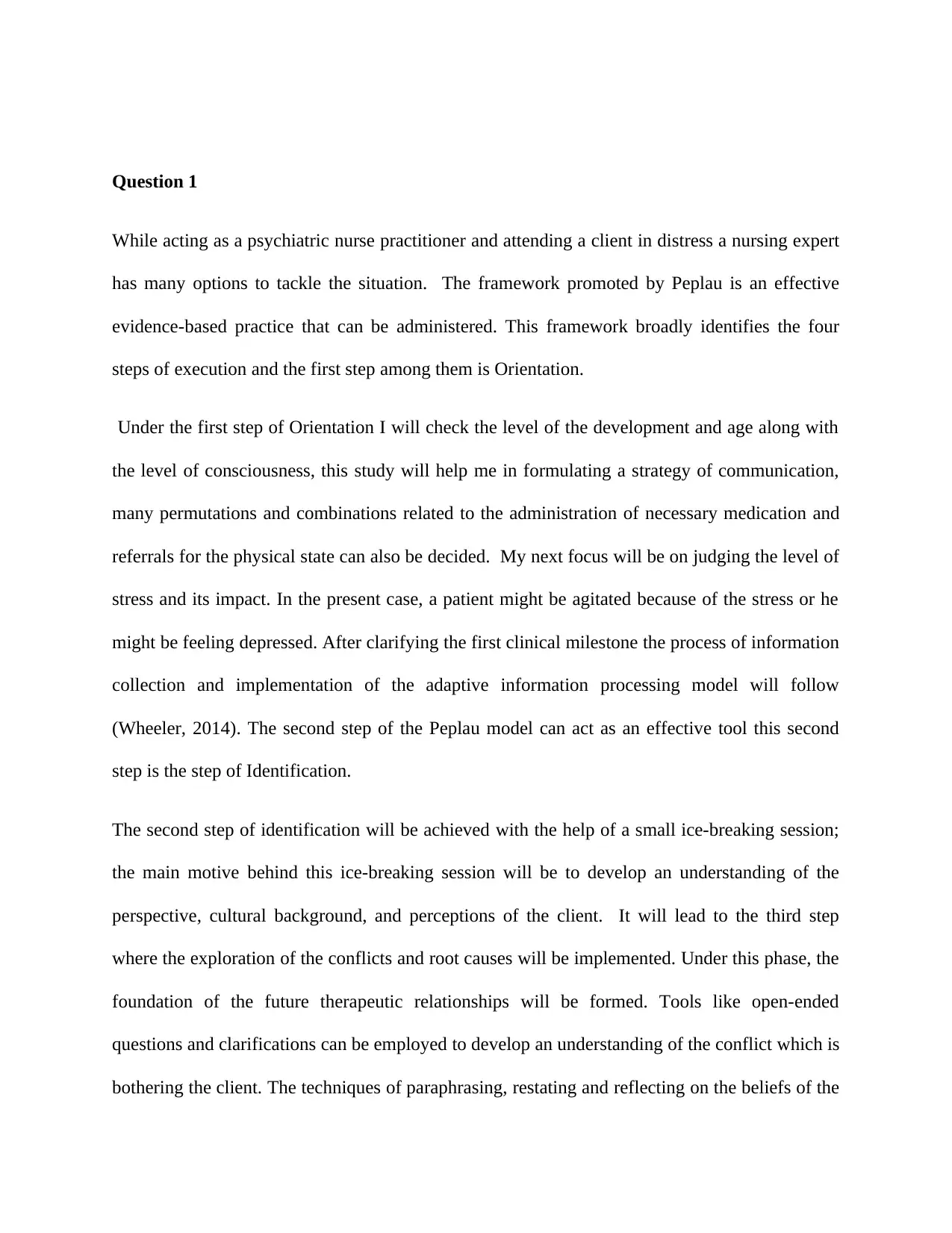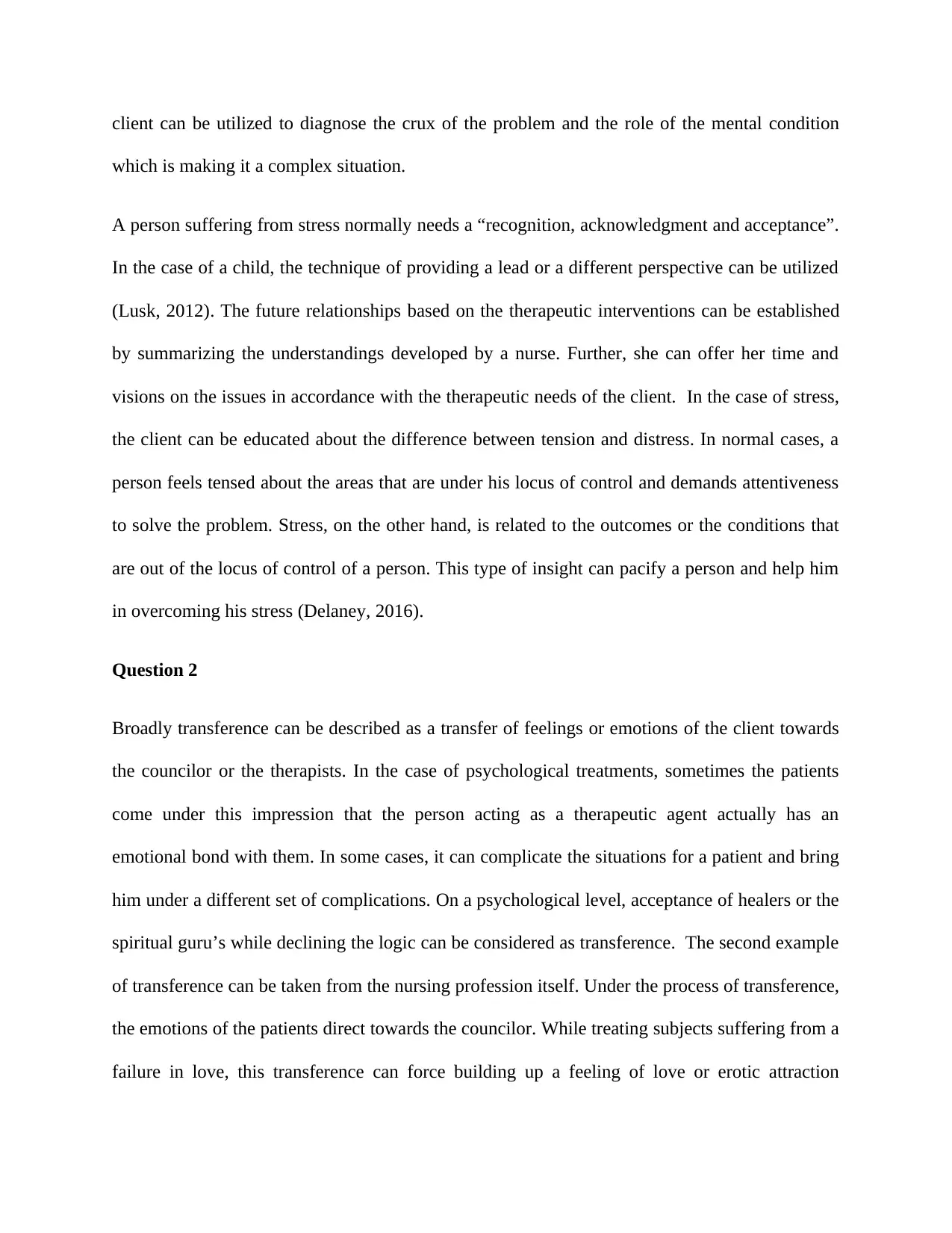Psychiatric Nursing: Implementing Peplau's Framework and Transference
VerifiedAdded on 2022/08/19
|6
|1070
|12
Homework Assignment
AI Summary
This assignment delves into the practical application of Peplau's framework in psychiatric nursing, focusing on the orientation, identification, and exploitation phases to manage patient distress. It emphasizes assessing the patient's developmental level, stress, and communication strategies. The assignment also explores transference and countertransference, critical concepts in therapeutic relationships, providing examples from nursing practice and highlighting the importance of professional boundaries. It discusses how transference can affect the therapeutic relationship and how countertransference can affect the therapist. The assignment provides detailed explanations of these concepts and their implications for patient care, supported by relevant references.

Paraphrase This Document
Need a fresh take? Get an instant paraphrase of this document with our AI Paraphraser

Question 1
While acting as a psychiatric nurse practitioner and attending a client in distress a nursing expert
has many options to tackle the situation. The framework promoted by Peplau is an effective
evidence-based practice that can be administered. This framework broadly identifies the four
steps of execution and the first step among them is Orientation.
Under the first step of Orientation I will check the level of the development and age along with
the level of consciousness, this study will help me in formulating a strategy of communication,
many permutations and combinations related to the administration of necessary medication and
referrals for the physical state can also be decided. My next focus will be on judging the level of
stress and its impact. In the present case, a patient might be agitated because of the stress or he
might be feeling depressed. After clarifying the first clinical milestone the process of information
collection and implementation of the adaptive information processing model will follow
(Wheeler, 2014). The second step of the Peplau model can act as an effective tool this second
step is the step of Identification.
The second step of identification will be achieved with the help of a small ice-breaking session;
the main motive behind this ice-breaking session will be to develop an understanding of the
perspective, cultural background, and perceptions of the client. It will lead to the third step
where the exploration of the conflicts and root causes will be implemented. Under this phase, the
foundation of the future therapeutic relationships will be formed. Tools like open-ended
questions and clarifications can be employed to develop an understanding of the conflict which is
bothering the client. The techniques of paraphrasing, restating and reflecting on the beliefs of the
While acting as a psychiatric nurse practitioner and attending a client in distress a nursing expert
has many options to tackle the situation. The framework promoted by Peplau is an effective
evidence-based practice that can be administered. This framework broadly identifies the four
steps of execution and the first step among them is Orientation.
Under the first step of Orientation I will check the level of the development and age along with
the level of consciousness, this study will help me in formulating a strategy of communication,
many permutations and combinations related to the administration of necessary medication and
referrals for the physical state can also be decided. My next focus will be on judging the level of
stress and its impact. In the present case, a patient might be agitated because of the stress or he
might be feeling depressed. After clarifying the first clinical milestone the process of information
collection and implementation of the adaptive information processing model will follow
(Wheeler, 2014). The second step of the Peplau model can act as an effective tool this second
step is the step of Identification.
The second step of identification will be achieved with the help of a small ice-breaking session;
the main motive behind this ice-breaking session will be to develop an understanding of the
perspective, cultural background, and perceptions of the client. It will lead to the third step
where the exploration of the conflicts and root causes will be implemented. Under this phase, the
foundation of the future therapeutic relationships will be formed. Tools like open-ended
questions and clarifications can be employed to develop an understanding of the conflict which is
bothering the client. The techniques of paraphrasing, restating and reflecting on the beliefs of the

client can be utilized to diagnose the crux of the problem and the role of the mental condition
which is making it a complex situation.
A person suffering from stress normally needs a “recognition, acknowledgment and acceptance”.
In the case of a child, the technique of providing a lead or a different perspective can be utilized
(Lusk, 2012). The future relationships based on the therapeutic interventions can be established
by summarizing the understandings developed by a nurse. Further, she can offer her time and
visions on the issues in accordance with the therapeutic needs of the client. In the case of stress,
the client can be educated about the difference between tension and distress. In normal cases, a
person feels tensed about the areas that are under his locus of control and demands attentiveness
to solve the problem. Stress, on the other hand, is related to the outcomes or the conditions that
are out of the locus of control of a person. This type of insight can pacify a person and help him
in overcoming his stress (Delaney, 2016).
Question 2
Broadly transference can be described as a transfer of feelings or emotions of the client towards
the councilor or the therapists. In the case of psychological treatments, sometimes the patients
come under this impression that the person acting as a therapeutic agent actually has an
emotional bond with them. In some cases, it can complicate the situations for a patient and bring
him under a different set of complications. On a psychological level, acceptance of healers or the
spiritual guru’s while declining the logic can be considered as transference. The second example
of transference can be taken from the nursing profession itself. Under the process of transference,
the emotions of the patients direct towards the councilor. While treating subjects suffering from a
failure in love, this transference can force building up a feeling of love or erotic attraction
which is making it a complex situation.
A person suffering from stress normally needs a “recognition, acknowledgment and acceptance”.
In the case of a child, the technique of providing a lead or a different perspective can be utilized
(Lusk, 2012). The future relationships based on the therapeutic interventions can be established
by summarizing the understandings developed by a nurse. Further, she can offer her time and
visions on the issues in accordance with the therapeutic needs of the client. In the case of stress,
the client can be educated about the difference between tension and distress. In normal cases, a
person feels tensed about the areas that are under his locus of control and demands attentiveness
to solve the problem. Stress, on the other hand, is related to the outcomes or the conditions that
are out of the locus of control of a person. This type of insight can pacify a person and help him
in overcoming his stress (Delaney, 2016).
Question 2
Broadly transference can be described as a transfer of feelings or emotions of the client towards
the councilor or the therapists. In the case of psychological treatments, sometimes the patients
come under this impression that the person acting as a therapeutic agent actually has an
emotional bond with them. In some cases, it can complicate the situations for a patient and bring
him under a different set of complications. On a psychological level, acceptance of healers or the
spiritual guru’s while declining the logic can be considered as transference. The second example
of transference can be taken from the nursing profession itself. Under the process of transference,
the emotions of the patients direct towards the councilor. While treating subjects suffering from a
failure in love, this transference can force building up a feeling of love or erotic attraction
⊘ This is a preview!⊘
Do you want full access?
Subscribe today to unlock all pages.

Trusted by 1+ million students worldwide

towards a person acting as a therapeutic agent (Kernberg, 2016). It can be established with the
help of a cross diagram and mostly it takes place on an unconscious level and manifests itself
with the help of unusual patterns.
Countertransference, on the other hand, refers to a condition where the therapist starts feeling the
surge of emotions or feelings of the patient or the subject. The APA guidelines for therapeutic
counseling clearly state the condition of “only necessary disclosure” of the feelings or emotions
in front of a patient to avoid both the conditions of transference and countertransference. In the
case of an unnecessary disclosure or acceptance of the feelings of a patient where it can cause a
catharsis, the process of countertransference can take place (Practice Guidelines for the
Psychiatric Evaluation of Adults, Third Edition, 2015).
The first example of transference can be the condition of trauma, let’s hypothetically assume that
a person shares the painful death of his child in front of the councilor and it reminds him of a
painful incident from his personal life. The feeling of rage or hatred towards any particular
community or any kind of offender can also cause a transference, for instance, while dealing
with Homosexual subject, feelings like Homophobia can overpower a counselor or a nurse.
help of a cross diagram and mostly it takes place on an unconscious level and manifests itself
with the help of unusual patterns.
Countertransference, on the other hand, refers to a condition where the therapist starts feeling the
surge of emotions or feelings of the patient or the subject. The APA guidelines for therapeutic
counseling clearly state the condition of “only necessary disclosure” of the feelings or emotions
in front of a patient to avoid both the conditions of transference and countertransference. In the
case of an unnecessary disclosure or acceptance of the feelings of a patient where it can cause a
catharsis, the process of countertransference can take place (Practice Guidelines for the
Psychiatric Evaluation of Adults, Third Edition, 2015).
The first example of transference can be the condition of trauma, let’s hypothetically assume that
a person shares the painful death of his child in front of the councilor and it reminds him of a
painful incident from his personal life. The feeling of rage or hatred towards any particular
community or any kind of offender can also cause a transference, for instance, while dealing
with Homosexual subject, feelings like Homophobia can overpower a counselor or a nurse.
Paraphrase This Document
Need a fresh take? Get an instant paraphrase of this document with our AI Paraphraser

References
Practice Guidelines for the Psychiatric Evaluation of Adults, Third Edition. (2015). APA
Practice Guidelines,
https://psychiatryonline.org/doi/full/10.1176/appi.books.9780890426760.pe02.
Delaney, K. (2016). Advanced Practice Psychiatric Mental Health Nursing, Finding Our Core:
The Therapeutic Relationship in the 21st Century. Perspectives in Psychiatric Care Vol.
42, No. 4, 215-216.
Kernberg, O. (2016). The four basic components of psychoanalytic technique and derived
psychoanalytic psychotherapies. Official Journal of the World Psychiatry,
https://www.ncbi.nlm.nih.gov/pmc/articles/PMC5032492/.
Lusk, P. (2012). COPE for Depressed and Anxious Teens: A BriefCognitive-Behavioral Skills
Building Intervention to increase Access to Timely, Evidence-Based Treatment. Journal
of Child and Adolescent Psychiatric Nursing,
https://www.researchgate.net/publication/51201656_The_Brief_Cognitive-
Behavioral_COPE_Intervention_for_Depressed_Adolescents_Outcomes_and_Feasibility
_of_Delivery_in_30-Minute_Outpatient_Visits.
Wheeler, K. (2014). Psychology for the advanced practice Psychiatric Nurses. New York:
Springer Publishing Company.
Practice Guidelines for the Psychiatric Evaluation of Adults, Third Edition. (2015). APA
Practice Guidelines,
https://psychiatryonline.org/doi/full/10.1176/appi.books.9780890426760.pe02.
Delaney, K. (2016). Advanced Practice Psychiatric Mental Health Nursing, Finding Our Core:
The Therapeutic Relationship in the 21st Century. Perspectives in Psychiatric Care Vol.
42, No. 4, 215-216.
Kernberg, O. (2016). The four basic components of psychoanalytic technique and derived
psychoanalytic psychotherapies. Official Journal of the World Psychiatry,
https://www.ncbi.nlm.nih.gov/pmc/articles/PMC5032492/.
Lusk, P. (2012). COPE for Depressed and Anxious Teens: A BriefCognitive-Behavioral Skills
Building Intervention to increase Access to Timely, Evidence-Based Treatment. Journal
of Child and Adolescent Psychiatric Nursing,
https://www.researchgate.net/publication/51201656_The_Brief_Cognitive-
Behavioral_COPE_Intervention_for_Depressed_Adolescents_Outcomes_and_Feasibility
_of_Delivery_in_30-Minute_Outpatient_Visits.
Wheeler, K. (2014). Psychology for the advanced practice Psychiatric Nurses. New York:
Springer Publishing Company.

⊘ This is a preview!⊘
Do you want full access?
Subscribe today to unlock all pages.

Trusted by 1+ million students worldwide
1 out of 6
Your All-in-One AI-Powered Toolkit for Academic Success.
+13062052269
info@desklib.com
Available 24*7 on WhatsApp / Email
![[object Object]](/_next/static/media/star-bottom.7253800d.svg)
Unlock your academic potential
Copyright © 2020–2025 A2Z Services. All Rights Reserved. Developed and managed by ZUCOL.


